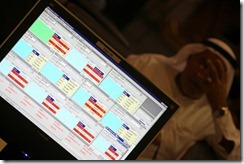The broadband revolution, both fixed and mobile, has resulted in telcos having to revise their business models quickly in an attempt to capture as much of the incremental revenues generated as possible. The telecom industry continues to grapple with the most effective way of seizing the broadband opportunity, though an understanding of the dynamics at play is becoming more apparent
 Reliable access to information is growing to become more of an expectation than a desire in the Middle East
Reliable access to information is growing to become more of an expectation than a desire in the Middle East
“I foresee data capping being used by more and more telcos in three to four years’ time as the amount of downloading increases,” predicted Ahmed Almaziad, general manager of Strategy Management at STC. “In the future we shall start to see subscribers downloading terabytes, and the amount of data will have to be monitored before it becomes excessive,” he added.
The higher speeds and capacity required to carry the increased data usage has been driving the investment in fibre networks in many parts of the Middle East, with many telcos looking to bundle services and offer triple and quadruple-play offerings.
Earlier this year, Oman’s Telecommunications Regulatory Authority (TRA ) approved a pilot project to connect households in Ma’bailah North and Ma’bailah South to a fibre-to-the-home (FTTH) network. The aim of the nine-month project is to test the technical feasibility of the fibre-optic infrastructure and the government has already allocated a budget for the deployment of a FTTH network as part of the Muscat Wastewater Project implemented by Haya Water Company.
The FTTH infrastructure will be rolled out by fixed line incumbent Omantel and second national operator Nawras, which will select users in a maximum of 400 buildings in the two regions. The selected users will be supplied with free high-speed Internet over the FTTH network during the trial period to test the service and ensure its stability.
Omantel has already deployed FTT H infrastructure in partnership with Huawei. The network was launched in March 2010 in newly developed residential areas of Muscat, providing broadband Internet at download speeds of up to 80Mbps, while also supporting services such as triple-play, video on demand and high-definition television.
“Shared FTTx infrastructure in Oman could be a potential game changer,” commented Richard Jones, partner at Ventura Team. The benefits of a shared investment in the infrastructure would aid the return-on-investment business case for the telcos, and potentially speed-up the time frame that they choose to deploy the technology.
“Costing is the challenge to the implementation of network sharing in the UAE,” said Ahmad Darwish, senior VP, Customer Service Engineering at Etisalat “That said, guaranteeing bandwidth is a key question, and from an Etisalat perspective in the UAE , we promise best effort on local content.”
Much of the content that is being accessed over broadband networks across the Middle East is hosted outside of the region, and Saleh Lagtaa, director of FAN Architecture at Du said he believes the local caching of content is something that needs to be considered seriously.
“The caching of content locally would help with the availability of content, as well as the speed and delivery of content,” he explained. And while there are discussions to share mobile broadband infrastructure in Saudi Arabia, no such discussions are underway with respect to fibre, with STC ’s Almaziad estimating the telco has already placed more than 30 kilometres of fibre into the ground.
In July, STC announced it had signed a comprehensive agreement with Olaya Real Estate Company to implement 1,000 kilometres worth of fibre-optic telecom infrastructure covering all of the real estate firm’s future projects across the kingdom.
The services agreement aims to prepare the infrastructure to deliver fibre-optic services and support, while staying abreast with the ‘Smart Neighbourhood’ strategy adopted by STC through its current projects. STC first announced it was rolling out FTT H technology in August 2010 – a first for Saudi Arabia – with the aim of offering Internet speeds of up to 100Mbps across the country. At launch the FTTH service was available in Riyadh, Jeddah and Dammam, with plans to expand coverage to most of the kingdom’s cities.
There is no explicit national strategy on FTTx in Saudi Arabia, and so the telcos in the market have taken up initiatives independently, which may not necessarily be the most efficient or effective manner to deploy fibre.
The sale of wireless data USBs has been a cornerstone of the laptop business for years, with subscribers demanding ever higher processing and connection speeds
The recent socio-political developments across the Middle East have highlighted people’s appetite to access the Internet, primarily to communicate with one another as well as to keep abreast with the world around them.
Mobile broadband growth in Egypt has been phenomenal in 2011, with the number of Internet users having grown from seven million before the commencement of the revolution early in the year, to around 25.6 million currently, according to Sherine Fouad, head of Strategy and Business Development at Vodafone Egypt.
“There are now 8.6 million Facebook accounts in Egypt, which is the second largest number in the Middle East and Africa after Turkey,” Fouad said. “This number represents 33 per cent penetration of Internet users in Egypt.”
With Internet users in Egypt reaching 25.6 million in 2011 out of an estimated potential user base of 33.5 million, the potential for offering reliable access to the Internet at decent speeds is one that is not wasted on the telcos. Etisalat Misr is building its own fibre network in the country, with Telecom Egypt currently being the only wholesale capacity provider and the only provider of dark fibre.
It is believed that Etisalat has been approached in the past to share its fibre network, having successfully shared 2G and 3G infrastructure with Mobinil in the past. No agreement has yet been announced with respect to sharing the fibre network.
Fouad described a number of different fibre sourcing models, including self-build fibre, fibre sharing, and wholesale access, all of which could expedite the deployment of services based on shared costs. The largest single cost in the deployment of fibre is civil works, which can account for as much as 68 per cent of the overall cost. Other services account for around nine per cent of costs, activities – 12 per cent, and the fibre optic cable itself, around six per cent.
The potential is thus great for the expansion of both fixed-line and wireless broadband data networks, both within Egypt as well as in many other parts around the region.
“Mobile data USB penetration grew from 28 per cent to 36 per cent in 2010, while ADSL penetration grew from 31 per cent to 33 per cent during the same period,” Fouad said.





0 comments ↓
There are no comments yet...Kick things off by filling out the form below.
Leave a Comment